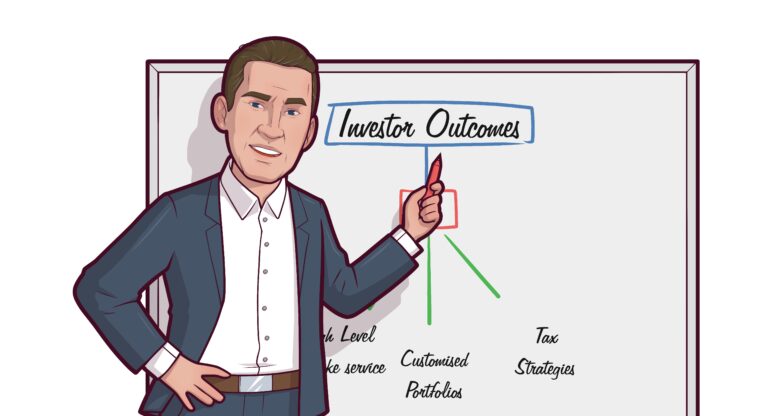Our previous post mentioned some particular asset returns from 2024. We also mentioned the divergence in Bonds, where short rates are coming down, yet long term rates have been going up.
Let’s dig into the broad asset class returns for 2024, and then consider the forward outlook and some attractive alternative income investments.
+31.20% International Shares (unhedged)
+17.60% Listed Property Trusts
+11.90% Global Infrastructure
+11.40% Australian Shares
+5.00% Fixed Term Deposits
+4.40% Cash
+2.90% Australian Fixed Interest (bonds)
The international shares performance came predominantly from US shares which gained 36% over the year. This has pushed valuations there into rather expensive territory, making future returns look less attractive.
To illustrate the case in point take a look at the chart below:

The price to earnings (P/E) ratio is not a timing tool, but a high price to earnings ratio portends lower returns ahead. The horizontal axis shows the price multiple of the index, versus the underlying earnings. Then the vertical axis shows the following 10 years return, based on the P/E ratio at the start. As you can see, when the P/E ratio is above the level where we are now, the annualised return ten years later is rarely above 0%.
Now, that does not mean that we shouldn’t invest in stocks at all. One of the prior periods of sky high P/E ratios in the USA market was in 1999 and 2000. There was a lost decade for the S&P 500 before the old highs were seen again. Yet there were other sectors that did just fine. In 1999 Listed property trusts were seen as ‘so last century’ yet they did were up while the Nasdaq fell 77% from its peak. Australian miners were denigrated as the tech bubble took hold, yet they too did very well in the subsequent years.
What we are saying is that it is time to be selective and look at sector diversification, or active managers.
Bonds & Fixed Income
In our previous issue we pointed out the weird goings on in Bonds, particularly the US market, which will of course lead the world. Since then things have gotten worse. Last week the US added 256,000 new jobs and the unemployment percentage fell to 4.1%. That helped push ten year US bonds up to 4.76%, now above the recent peak of 4.70% set back in April 2024.
A ten year bond rate above 5% may be a sign to up-weight bonds, and down-weight equities.
What can I get in Fixed Income?
Great question. The first thing to understand is you can’t ‘get’ last years return unless you invested at the start of last year! It frustrates me to hear someone confidently proclaim “I can ‘get’ 30% returns investing in US stocks”. What you see historically is last years return. That return is gone. Wise in hindsight. In fact, just as trees don’t grow to the sky, an outsized return last year may mean below average returns this year.
With that in mind, consider again the question ‘What can I get in Fixed Income?’
Annuities
A guaranteed annuity from Challenger Annuity currently provides:
1 Year 4.55% (monthly payments)
2 Years 4.70% (annual payments)
3 Years 4.80% (annual payments)
5 Years 4.85% (annual payments)
Term Deposits
Term deposits via Australian Money Market are 5.05% for 1 year, 4.60% for two years, and 4.40% for three years.
Bonds
Government Bond rates have been moving around a bit. Current Australian yields are 3.93% p.a. for 2 years, 3.96% for 3 years, and 4.60% for 10 years. A variety of different government bonds can now be bought via a stock broking account if you want the highest security and liquidity.
In corporate bonds, AA rated bonds have yields around 5.0% at present. Going further down the credit score, things like the Woolworths 2031 maturity bond yields 5.37% p.a. while the Aurizon 2034 bond, yields 6.13% p.a. to maturity. These are the type of assets held in the Janus Henderson Tactical Income fund, Daintree Core Income, and the ETF CRED, issued by BetaShares.
While delving into the Fixed Income market, I will also name a few Exchange Traded Funds (ETF’s) that are available on the ASX, which can be used to play specific views on various bond markets. These are not necessarily recommendations for right now, but it is worth knowing about them to trade specific views.
GGOV (Betashares) is an exposure to the 20 year US treasury bond market, but hedged back into Aussie dollars. It could be used if you think that the US economy is going into recession, but are concerned the USD is going to fall vs the AUD. They also have a 7-10 year version with the code US10.
UTIP (Betashares) is an exposure to US Inflation Linked government bonds, also hedged back into AUD. They give you a known return above inflation over the term to maturity. For example right now the yield is about 2.3% + whatever inflation occurs over the next 10 years. If inflation averaged 3% then the total return is 5.3% per annum, without needing to be concerned about inflation taking off. We may be close to a buying opportunity in this asset class, as 2.3% real is above the level it has traded at for most of the last 20 years. (Peak was 3.00% in late 2008, when everyone was selling everything).
5GOV (VanEck) is an ETF with a portfolio of 5 to 10 year Australian Government Bonds. As at 31/12/2024 the yield to maturity was 4.63% p.a. and the average maturity was 7.56 years. Obviously, if interest rates were to fall, you could also pick up some capital gains in the short term. If held for the next 7 years though, you would expect around the 4.63% per annum, with government security. VanEck also issue 1GOV, which is a 1 to 5 year average maturity, and a XGOV which is 10+ years average maturity.
Currency
While on the topic of useful ETF’s that can be used to express a particular economic viewpoint, there are a couple of currency ETF’s to add to the list.
YANK (Betashares) is a geared ETF that invests in US Dollars. If you think the Aussie is headed lower, this can gain value as the AUD falls. It is up about 32% since October 2024. The inverse of this is AUDS which is a geared AUD fund. It is down 21% since October, but could be used if the AUD appeared to have bottomed.
Mortgages
First mortgage lending is an area where you can generate good income, often well above other fixed income sectors. In the past there have been some major collapses in this sector, (City Pacific, MFS and others in 2008, and before that Estate Mortgage in 1990). But others lived through that period and survived. We are currently doing business with Balmain Direct mortgages, where the loan you make is pooled with others to lend on a first mortgage over a specific piece of real estate. Net returns on these loans are up around 8.5%+ with monthly income. Loans can be hand picked in conjunction with your adviser, and you only lend on a property with a loan to valuation ratio that you are comfortable with.
Some pooled mortgage lenders we also like are MA Financial, Trilogy, and LaTrobe. They all have slight differences.
MA Financial has two funds of interest here. MA Secured Loan Series Class A. This is an investment into a pool of mortgage assets, where the average term is around 12 months. The Series A units take priority over the Series B units, with the latter providing a buffer to any losses. Return over the last 2 years has been 9.20% per annum. This fund is only available to accredited Wholesale investors.
The MA Priority Income fund is more diversified. The loans can include auto loans, strata finance, personal loans, debtor finance, as well as mortgages on commercial or residential loans. MA Financial, (previously Moelis Australia) provides 10% of the capital in the fund. That serves as a ‘first loss’ buffer. The expected returns are RBA cash plus 4.00% net of fees. That would imply around 8.35% p.a. at present. It is open to Retail and Wholesale clients.
Trilogy Funds have a first mortgage fund called the Trilogy Monthly Income Trust, and is available either via direct application or on most platforms. The fund is predominantly focused in construction lending. The main sectors are, townhouse construction, apartment construction and land subdivisions. The current annualized distribution rate is 7.85% per annum.
LaTrobe have been making first mortgage loans in Australia since 1952. Their flagship fund is the LaTrobe 12 month Term Account, which currently pays 6.75% per annum. This fund has exposure to nearly 10,000 different loans, making the risk very diversified. Unlike the Trilogy funds, the LaTrobe fund is more focused on plain vanilla mortgages over existing assets. Think of a business owner who may not meet the bank criteria for a loan, the next stop is someone like LaTrobe who will lend on asset values, rather than being cashflow driven like a bank.
These are some of the options currently available in the mortgage market.
Private Credit
Private credit refers to loans provided by non-bank lenders, typically asset management firms, to businesses. It involves privately originated and held debt instruments not traded in public markets. This form of lending often targets small and medium-sized enterprises that may not qualify for traditional bank loans or public bond offerings. (explanation by AI – Perplexity).
This is a very broad church. The mortgage funds we described above are just one part of ‘private credit’.
Ares Diversified Credit Fund is only available to Wholesale investors, but it enables investors to tap into the experience of a highly regarded private credit manager. Ares are based in the US, and have been in private markets since 1997. The fund has a long track record of successful lending to mid sized private businesses for either expansion capital or acquisitions. It can also extend into Collateralized Loan Obligations, as well as High Yield bonds when opportunities arise. Last 12 months return was 10.54%, but on a go forward basis with current interest rates it is feasible to think around 8%. Importantly this is diversified away from Australian real estate.
Another of the Ares funds we like is the Ares Global Credit Income Fund. This one is available to retail investors. With a short duration, the fund income will go up and down with interest rates, but at present the running income is 6.19%. Worst peak to trough loss in the last 3 years was -5.78%.
Conclusions
The Lonsec Research team’s forward return outlook (next ten years) for Australian Equities is 7.5% per annum and their forecast for Global Unhedged equities is 6.9% per annum.
Since higher historic returns have now reduced the future return expectation, we can see the rationale to replace some equity exposure with a few of these alternative income funds. It is true that they may not classify as ‘traditional fixed income’ which is typically government bonds with a bit of credit, but they can replace a portion of your equity allocation. This would be reflective of the elevated risk that they have (like equities), but also acknowledgment of the fact that equities are not likely to repeat last year’s returns.
Building a diversified portfolio of some of these alternative income funds can add an un-correlated source of returns.

